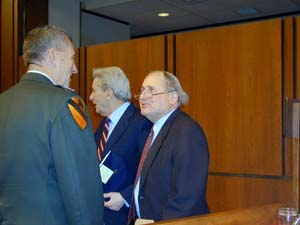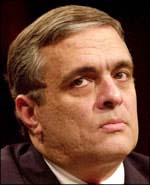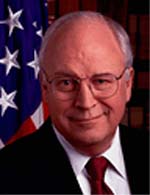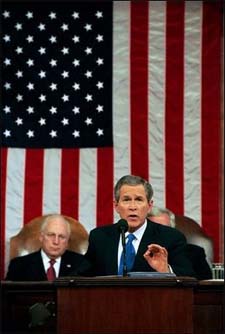
|
By U.S. Senator Carl Levin (D-Michigan) Congressional Record 108th Congress First Session Tuesday, July 15, 2003
Even more troubling, however, is the fact that the uranium statement appears to be but one of a number of several questionable statements and exaggerations by the Intelligence Community and Administration officials that were issued in the buildup to the war. The importance of objective and credible intelligence cannot be overstated. It is therefore essential that we have a thorough, open and bipartisan inquiry into the objectivity, credibility and use of U.S. intelligence before the Iraq war. First, relative to the uranium issue: the President in his State of the Union message said that the British government had learned that Iraq recently sought to purchase significant quantities of uranium from Africa. The sole purpose of that statement was to make the American people believe that the American government believed the statement to be true and that it was strong evidence of Iraq's attempt to obtain nuclear weapons. But the truth was that, at the very time the words were spoken, our government did not believe it was true. Condoleezza Rice's effort to justify the statement on the grounds that it was "technically accurate" doesn't address the heart of the matter, which is that the statement was calculated to create a false impression. It is simply wrong to make a statement whose purpose is to make people believe something when you do not believe it yourself. It is all well and good that the CIA has acknowledged its role in caving in to pressure from the National Security Council to concur in something which it did not believe. But Director Tenet's acknowledgment raises further questions of who was pushing the false impression at the National Security Council. The NSC should not misuse intelligence that way.
Aluminum tubes: In a speech before the UN General Assembly on September 12th, 2002, President Bush said "Iraq has made several attempts to buy high-strength aluminum tubes used to enrich uranium for a nuclear weapon." In fact, an unclassified intelligence assessment in October acknowledged that some intelligence specialists "believe that these tubes are probably intended for conventional weapons programs," and on February 5th, 2003, Secretary of State Colin Powell told the UN Security Council that "we all know there are differences of opinion," and that "there is controversy about what these tubes are for." The International Atomic Energy Agency, after conducting an inquiry into the aluminum tubes issue concluded they were not for uranium enrichment. Iraq-al Qaeda connection: On September 27 of last year, Secretary of Defense Donald Rumsfeld described the Administration's search for hard evidence for a connection between Iraq and al Qaeda. He said "we ended up with five or six sentences that were bullet-proof. We could say them, they are factual, they are exactly accurate. They demonstrate that there are in fact al Qaeda in Iraq." While Secretary Rumsfeld later went on to say "they are not beyond a reasonable doubt," he did not say there was considerable uncertainty in the Intelligence Community about the nature and extent of ties, if any, between Iraq and al Qaeda. It was certainly never a "bullet- proof" case.
Mobile biological warfare labs: On May 28, 2003, the CIA posted on its website a document it prepared with the Defense Intelligence Agency entitled "Iraqi Mobile Biological Warfare Agent Production Plants." This report concluded that the two trailers found in Iraq were for biological warfare agent production, even though other experts and intelligence community members do not agree with that conclusion, or believe there is not enough evidence to reach such a conclusion. None of these alternative views were posted on the CIA's web page. White House Web Site Photos: On October 8, 2002, the White House placed three sets of satellite photos on its web site, with the headline "Construction at three Iraqi nuclear weapons-related facilities". Although one of the facilities was not nuclear-related, the captions of the photos gave the impression that Iraq was proceeding with work on weapons of mass destruction at these facilities, although UNMOVIC and IAEA inspections at these facilities found no prohibited activities or weapons. For the Al Furat Manufacturing Facility, the caption notes that "the building was originally intended to house a centrifuge enrichment cascade operation supporting Iraq's uranium enrichment efforts," and that after construction resumed in 2001, "the building appears operational." So the misleading statement about African uranium is not an isolated issue. There is a significant amount of troubling evidence that it was part of a pattern of exaggeration and misleading statements. That is what a thorough, open and bipartisan investigation should examine.
4. Who at the CIA knew about the decision to tell the British intelligence service in September, 2002 of CIA's "reservations" about the inclusion of references to Iraqi efforts to obtain uranium from Africa in the British intelligence service's September 24 dossier? 5. Given the doubts of the U.S. Intelligence Community, why didn't the President say in his State of the Union speech not only that "The British government has learned that Saddam Hussein recently sought significant quantities of uranium from Africa," but that "our U.S. Intelligence Community has serious doubts about such reporting"? 6. How and when did the US government receive the forged documents on Niger, and when did it become aware that they might be bogus? 7. What role did the Office of the Vice President have in bringing about an inquiry into Iraq's purported efforts to obtain uranium from Africa? Was the Vice President's staff briefed on the results of Ambassador Wilson's trip to Africa? These and many other questions underscore the critical importance of a thorough, open and bipartisan inquiry into the objectivity and credibility of intelligence concerning the presence of weapons of mass destruction in Iraq immediately before the war and the alleged Iraq-al Qaeda connection, and the use of such intelligence by the Department of Defense in policy decisions, military planning and the conduct of operations in Iraq. |
|
 Democratic Sen. Carl Levin (right, here with Gen. Tommy Franks) is the ranking member of the U.S. Senate Armed Services Committee
Democratic Sen. Carl Levin (right, here with Gen. Tommy Franks) is the ranking member of the U.S. Senate Armed Services Committee CIA George Tenet is at the eye of the political storm over Bush's State of the Union misinformation
CIA George Tenet is at the eye of the political storm over Bush's State of the Union misinformation  National Security Advisor Condolezza Rice said that the government never thought Iraq had nuclear weapons, but in the lead-up to war Dick Cheney said the government did believe Saddam was moving toward a nuclear weapondry
National Security Advisor Condolezza Rice said that the government never thought Iraq had nuclear weapons, but in the lead-up to war Dick Cheney said the government did believe Saddam was moving toward a nuclear weapondry  Bush delivers his State of the Union and puts his foot in his mouth
Bush delivers his State of the Union and puts his foot in his mouth